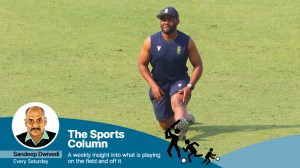Bound by Signs
An indigenous Bedouin sign language could show how the human mind works

Talking HandsMargalit Fox
Simon & Schuster, $23.65
Fascination with the language instinct is so strong that no matter how many times one may have come across Helen Keller’s story, there is a certain point when one gets goosebumps. It’s the point when Keller, a deaf-blind child running wild with not a way known to her to communicate with the world, learns the sign for water. How she cognitively connects cool water with a sign taught by a teacher is a moment brimming with mystery and awe. Such moments are the holy grail for linguists. Their still fledgling discipline finds in these moments the boldest clues yet for insights into how the human mind works and organises itself.
Margalit Fox, a New York-based journalist with a master’s degree in linguistics, tells the story of a Bedouin village in Israel that has become the subject of a study by linguistics to answer the most cutting-edge questions about human mind. The identity of the village and its inhabitants has been protected to prevent them from becoming curiosities for tourists, but the account is absorbing.
She calls the village Al-Sayyid. It is the best instance of what’s called a signing village, where the majority of residents can communicate by sign language. “Of Al-Sayyid’s 3,500 residents about one in twenty-five is deaf — 4 per cent of the population. For deafness a rate of 4 per cent is a staggering figure: in Israel, as in the United States, the incidence of deafness in the general population is about 0.1 per cent, one in a thousand.”
Fox intersperses observations on Al-Sayyid with overviews on the major milestones in linguistic and, specifically, the study of sign languages. Given the genetic predisposition among its people to deafness — strengthened by inter-marriage — and the fact that they have been settled there for just about 70 years, Al-Sayyid is unique for two reasons. One, given the prevalence of deafness, its hearing residents also sign. Therefore, there is a purer interaction in sign, because elsewhere it is the hearing impaired who supplement it with lip-reading and other skills to communicate. Two, the sign language in Al-Sayyid is indigenously developed. Unlike so many sign languages around the world, it does not have major inputs from other languages. Also, Al-Sayyid Bedouin Sign Language is a few decades old, so researchers can try to reach back to the earliest moments of its creation.
It is akin to actually conducting a Forbidden Experiment, every researcher’s fantasy, where people are sent into controlled isolation so that their development can be monitored and theories tested. (Forbidden, of course, on ethical grounds.)
Fox was allowed restricted access to Al-Sayyid, but she spent more time with the researchers, two Americans and two Israelis. But she collates her observations of the desert with the work of the researchers with a sustained sense of wonderment. As her traveller’s eye takes in the locale and the cultural richness found in Al-Sayyid, she refrains from over-dramatising the interactions in the village. The magic in the discovery is that Al-Sayyid Bedouin Sign Language, so exceptional to researchers, is so natural to the residents.



- 01
- 02
- 03
- 04
- 05




























